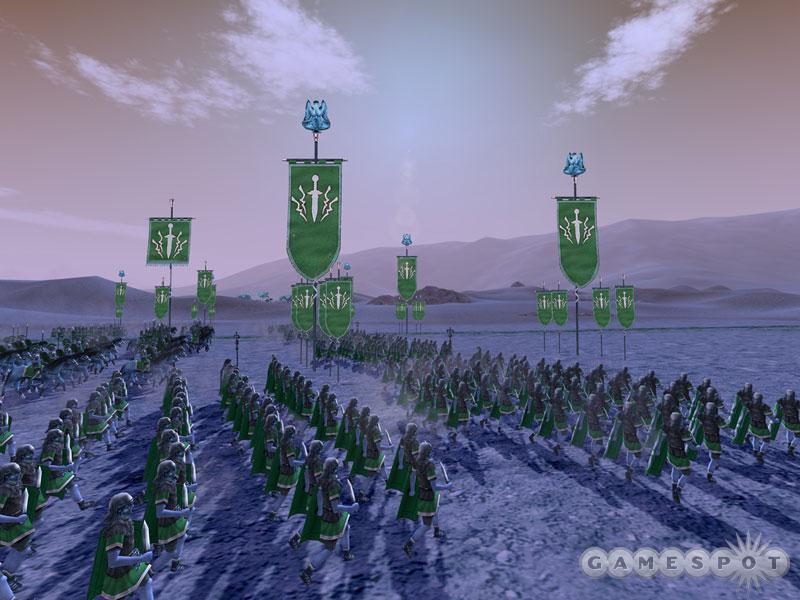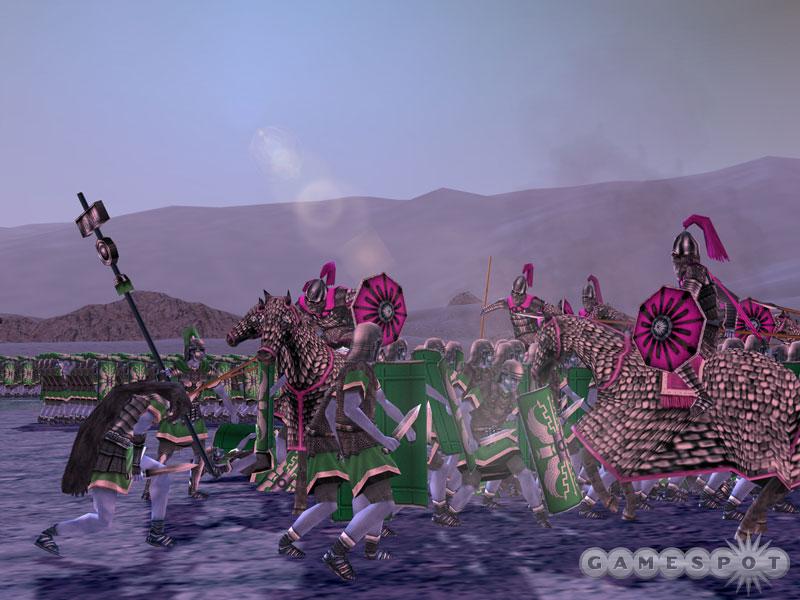Rome: Total War Designer Diary #1
Lead programmer Jerome Grasdyke explains what you can expect from Creative Assembly's next epic strategy game.
If you were a cynic, you could claim that real-time strategy games are all about building up resources, building up a base, and building up armies as quickly as possible to win. Fortunately, the PC has seen many excellent and highly innovative strategy games that break away from this structure, like Creative Assembly's Total War series, for instance. The series has previously focused on such real-world historical periods as feudal Japan and medieval Europe, and the next game in the series, Rome: Total War, will chronicle the rise of the Roman Empire. Like previous games in the series, Rome: Total War will have a strategic, turn-based mode that lets you plot dastardly political schemes, in addition to a real-time battle mode that will render thousands of troops onscreen at once. However, Rome will also feature an overhauled graphics engine that will include far more detailed units and cities, among other things. The developers at Creative Assembly have graciously agreed to share the details of this ambitious game's development in this series of designer diaries.
Let Slip the Dogs of War
By Jerome GrasdykeLead Programmer, Creative Assembly

Greetings! In this first episode of the Rome developer diaries, I'm going to attempt to give an overview of what we've been up to here in deepest, darkest Southwater, UK.
"All roads lead to Rome." Sigh. "Rome wasn't built in a day." Groan (swiftly followed by a thrown shoe). These phrases have been used enough times around Creative Assembly's spacious offices in rural England that the whole team responds to them with communal complaints. But, in fact, they contain more than a grain of truth. It's been a good three years since Managing Director Tim Ansell invited yours truly into his office for a brief chat, the gist of which went something like, "How would you like to start work on Rome: Total War? It's going to need all-new design and technology--with all the soldiers in 3D, motion-captured animations for the units, and a richer campaign map." In hindsight, it was a modest beginning for a project that would snowball into a team of more than 30 people spread across two continents, with 1.6 million lines of code and tens of thousands of art pieces. It's even spawned a popular TV series on the BBC.
Rome was intended from the beginning to reinvent the Total War series by updating the technology and introducing fresh concepts. We had many ambitious ideas--such as multiple campaigns, detailed cities and hinterlands, and a mission-driven senate, to name but a few--that vied with established concepts for inclusion in the final game. Some didn't make the cut as key elements from previous Total War games were fitted into place. The epic battles involving thousands of men still form the heart of the game, and there are still two environments to play in--one turn-based and one real-time. People who have played Medieval: Total War will find many familiar elements in Rome: Total War, but there is also much that is different. As they say in the whiskey industry, "It's all in the blend."
The campaign map has undergone the most drastic changes. The parchment map from the earlier games is gone, and it's been replaced by a top-down view of a more-realistic world that shows landscape features, such as heights, seas, mountain passes, and forests. Cities and generals with armies are placed here and there, and characters now walk across the map, striding about like giants of the ancient world. They can hide in forests, block passes, construct forts, spy on the enemy, and much more. Many new gameplay elements come from this. Provinces still cover varying areas across the world and mark the terrain governed from the provincial capital. If you conquer the city, you will own the province. With these features in place, we started to bring the world to life by gradually introducing summer and winter seasons, roads, ports, trade links across the sea, disasters, and climates.
Within this world we placed 21 factions that are divided into six cultures. No game about ancient Rome would be complete without the early Punic Wars between the Carthaginians and the Roman Republic or the later ones against the Germanic barbarians. The other factions are distributed across the world so that they capture, as much as possible, the flavor of the times. You'll find Britons, the Greek City States, the Seleucid Empire, and Egypt all in their familiar places. Each of the factions has been given an individual tech tree, and each can build around 30 buildings, some of which are shared within the cultures. The same also holds true for the units. There are more than 200 different troop types in the game--with approximately 20 unit types per faction--and many are unique. We've included elephants and chariots, mobile siege artillery (including onagers, ballistae, and scorpions), praetorian guards, hoplites, sacred band cavalry, and of course, several varieties of Roman legionary. Many of these units also have special abilities, such as the chariot's ability to scythe down men on either side as it charges, or the legionary's ability to form a "testudo" (or "turtle") formation. It's an incredibly rich historical tapestry, which ensures that as you play the campaigns, you will continue coming up against new units and new tactical problems.
The Battles of the Ancient World
In the battles, the main change has been made to the polygonal units, which allow us to do many things we couldn't do before. Making the combat look awesome when you bring the camera in close has brought with it a number of challenges, especially in the area of managing actions and animations for the characters. For example, on a given battlefield, there could be one group of elite hoplites marching around in a phalanx formation, with each hoplite doing slightly different things. Elsewhere, an equites cavalry troop might be charging toward a velite formation, and yet somewhere else, triarii spearmen could be scaling ladders to get on to a wall. Then, once the troops enter combat, the range of activities increases even further. There are more than 2,000 motion-captured animations in the game, and there are many ways of using them singly and in combination. The code that deals with this has ended up being some of the most complex in the game.

We knew that siege battles would become an integral part of the game, and we planned from the beginning to concentrate a large part of the effort on making the sieges fun, spectacular, and colorful. There are huge, epic cities, some really very large walls, indeed, and plenty of ways to destroy or capture them. In addition to using catapults, there are rams, siege towers, and sets of siege ladders to help during assaults, and each item has its advantages and disadvantages. The ram, for example, provides cover against missile fire, but as it is used against city gates, boiling oil may be used against your troops. The siege tower allows a group of soldiers to burst onto the platform at the top of a wall together, but it is slow to move into position, and the men moving it may be fired upon by missile troops. The ladders, on the other hand, are quick to position, but they only allow men to climb in single file. As a result, they arrive one at a time, so the wall's defenders will always outnumber their attackers at the top. Choices, choices... Once inside the city, you'll have the opportunity to destroy its buildings, or you can try to capture it (whole), along with the rest of the settlement.
As you play, you'll notice that almost everything that is present in the campaign game also appears on the battlefield. If you look into the far distance, you'll see mountains, seas, and cities in the right places. When you look at the battlefield around your troops, there are the right amounts of forests and hills, thus matching what the ground looks like on the campaign map. You fight on a campaign map location, which contains a fort, and the fort is there for the defenders to hole up in. And, of course, when you attack a settlement, the buildings that were built there in the campaign game are present and can be attacked as well. When you come out of a campaign battle having successfully defended your settlement, you will see the damage to your walls and buildings reflected in the campaign game. Luckily you can choose to repair this damage. There are many of these links between the campaign and battle maps. They demonstrate that in Rome, unlike previous Total War games, the world is a seamless whole seen in two different ways rather than presenting itself as two games that you play together.
Overall, the game is huge, but we've spent a lot of time and effort to make it as intuitive and easy-to-play as possible. A prologue has been added to the main campaign, which gradually introduces the main concepts as you play, and the in-game adviser will provide hints throughout play as you try new things. In addition, there are many automanagement options that allow you to take as much or as little control as you like, and they even go so far as to allow the AI to do all of your building and training for you so that you can concentrate on fighting battles.
Hopefully that gives you some idea of what Rome's about. For now, the game's alpha milestone has come and gone, so we're on the way to serving up a veritable smorgasbord of strategy later this year. And all that is without even mentioning the historical figures from the ancient world, the ruling dynasties for the factions, the senate, and the new auto-linkup feature, which makes it a great deal easier to maneuver large formations. But then, this is only the first diary. Stay tuned for future installments, in which all these game features will get discussed--and much more.
Got a news tip or want to contact us directly? Email news@gamespot.com
Join the conversation